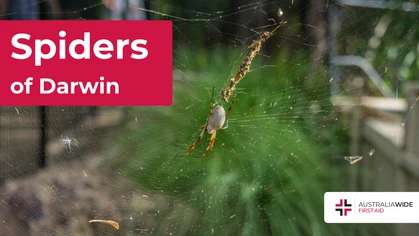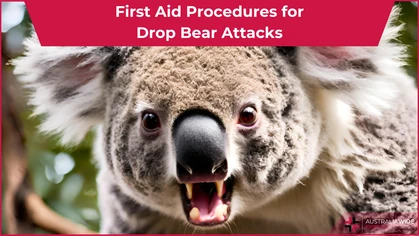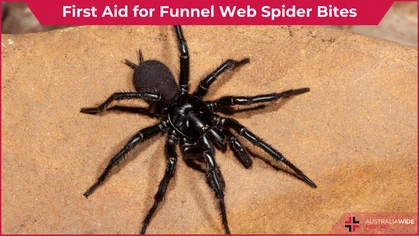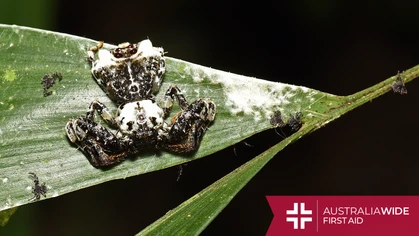3 Common Australian Outdoor Spiders

Bites and Stings

Australia is home to approximately 10,000 spider species, several of which we are likely to encounter while doing odd jobs around the backyard or venturing through bushland. Let's take a look at these spiders and whether they are cause for concern.
Out in the Australian wild, we don’t have to worry about apex predators like bears, wolves, and cougars. We must, however, be wary of several spider species that are common throughout bushland and the humble family backyard. It is worthwhile noting, there have been no deaths in Australia from a confirmed spider bite since 1979 (according to the Australian Museum). In fact, you are more likely to die from a bee sting than a spider bite. However, almost every Australian spider contains some type of venom, which can cause a host of nasty symptoms. As such, it is important to become familiar with the characteristics and behaviour of the spiders likely claiming residency in your backyard and nearby bushland. That way, you can enjoy the Australian wilderness without fear of retribution from the resident arachnids. With that being said, let’s take a closer look at 3 of Australia’s most common outdoor spiders!
Garden orb weaving spiders are considered 'master backyard builders' - their intricate, wheel-shaped webs can be so big as to extend from one tree to the next. Sometimes, their webs are so strong they can trap small birds.
Garden Orb Weaving Spider
The Garden orb weaving spider belongs to the Araneidae family of spiders. They are so named because of the large, intricate ‘orb’ shaped webs they build to catch flying insects. There are approximately 100 known species of Garden orb weaving spiders originating from Australia alone. As such, their appearance can vary from one spider to the next. In saying that, Garden orb weaving spiders are typically grey to reddish brown in colour and only grow 15 to 30 millimetres (mm) in length. Likewise, their abdomens tend to be bulbous, triangular, and covered in fine hairs. Garden orb weaving spiders are native to Australia, and the most common species are generally found in southern and eastern parts of the country. They are known for suspending wheel-shaped webs high in the air between trees and shrubs, which they use to catch flying insects like flies, beetles, and cicadas. Garden orb weaving spiders tend to be shy and non-aggressive and will only bite when provoked. And though they do contain venom, it largely has no impact on humans and will generally only cause mild pain and swelling at the bite site. To avoid this discomfort, take care to look where you are going while walking through bushland, save you end up with a Garden orb weaving spider on your face!
Wolf spiders are distributed across the globe in a range of habitats, including shrublands, woodlands, and rainforests. Many species of Wolf spiders reside in burrows, from which they prey on ground-dwelling invertebrates like crickets and ants.
Wolf Spider
The Wolf spider belongs to the Lycosidae family of spiders. They are so named because they use their superb agility and eyesight to stalk their prey in the dead of night, much like a wolf. There are roughly 2,400 species of Wolf spiders scattered across the globe, many of which have their own distinct characteristics and can range in size from 1.2 to 5 centimetres (cm). In saying that, Wolf spiders are typically drab in colour with variegated patterns of grey, brown, or black markings. They also tend to be hairy, and their uppermost row of eyes sits at the top of their rounded head, which affords their excellent eyesight. Though Wolf spiders are known to build their burrows in a range of coastal and inland habitats, Australia’s most common Wolf spider, the Garden wolf spider (Tasmanicosa godeffroy), prefers open woodlands and suburban backyards. They tend to run away from trouble and will only bite when threatened – for instance, if you inadvertently dig one up while tending to your garden. Likewise, their venom generally only causes mild symptoms, such as localised pain or itchiness at the bite site. As such, if you accidentally dislodge a Wolf spider from their hole in the ground, there is no need to panic – simply allow them to scurry away and build a new home elsewhere.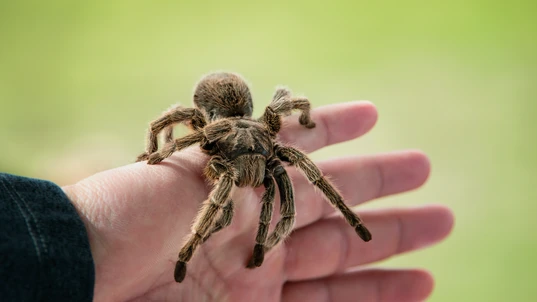
Tarantulas are widely distributed throughout the world, from all over the Americas to certain parts of Asia. They prefer the dark and build burrows underground, from which they prey on insects and small vertebrates like toads and mice.
Tarantula
The Tarantula belongs to the Theraphosidae family of spiders. Their name can be traced back to a species of Wolf spider originating from the southern Italian town of Taranto. Across the globe, there are over 1,000 species of tarantula, many of which vary in colour and behaviour according to their specific environment. Most tarantulas, however, have large bodies that are a certain variant of brown and covered in thin hairs or fur that lend a silvery sheen. Their body also tends to range from 3 to 8 cm in length, while their legs can span up to a whopping 16 cm. In Australia, tarantulas build their web-lined burrows in a variety of habits ranging from rainforest to desert. Tarantulas are not usually aggressive, which is why upwards of 10,000 Tarantulas are taken from the wild every year to be sold as exotic pets. In saying that, they may ‘rear up’ when provoked to appear menacing. And though their venom generally has low toxicity to humans, their fangs are large and can inflict painful bites sometimes characterised by nausea and vomiting. As such, no matter how gentle and slow-moving a Tarantula may seem, you should never attempt to handle it. In fact, the Australian Museum purports that an increase in reported Tarantula bites could be tied to their growing popularity as pets.First Aid for Common Australian Outdoor Spider Bites
Bites from the spiders mentioned in this article can be treated with the same first aid procedure used for Redback spider bites:- Reassure the casualty and keep them under constant observation.
- Apply a cold compress to the bite site for periods of up to 20 minutes to lessen the pain.
- If the casualty is a young child (under 8 years), a pregnant woman, or if they exhibit any signs of deterioration, follow the basic life support guidelines per DRSABCD and call Triple Zero (000) for an ambulance.
- DO NOT use the Pressure Immobilisation Technique, as the venom moves slowly and this will just worsen the pain.
Spider Bites and Anaphylaxis
Some people can have a severe allergic reaction when bitten by a spider. This is called anaphylaxis, a condition that can be fatal in as little as 15 minutes. Symptoms include:- Tightness of the throat from swelling.
- Difficulty breathing.
- Tongue and facial swelling.
- Hoarse voice or difficulty speaking.
- A wheeze or persistent cough.
- Collapse or falling unconscious.
- Becoming pale or floppy (young children).
- Abdominal pain and vomiting.
- Hives, welts, and body redness.
Final Thoughts
Australia is home to over 2,700 spider species. Though spider bites are rarely fatal, and only 2 Australian spider species have killed humans in the past (the Redback and the Funnel-web), it is important to be familiar with the behaviour and characteristics of Australia’s most common outdoor spiders. As we have seen here today, the spiders that you are likely to encounter while tending to your garden or venturing through bushland are generally non-aggressive in nature and prefer to run away in the face of danger. However, if provoked, they may issue a nasty bite characterised by localised pain, swelling, or nausea. As such, always take heed of your surroundings and never stick your hands or feet into places you can’t see. And if you do come face-to-face with a spider, allow them to scurry away to safety. For more tips and tricks on how to prevent spider bites, book a First Aid course with Australia Wide First Aid today.
Originally published at
https://www.australiawidefirstaid.com.au/resources/common-australian-outdoor-spiders
as part of the Australia Wide First Aid Articles Library
